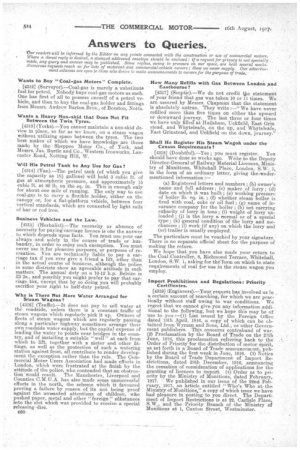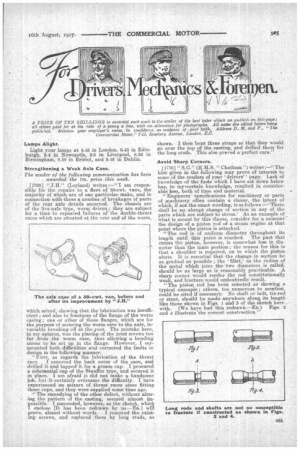Answers to Queries.
Page 18

Page 19

If you've noticed an error in this article please click here to report it so we can fix it.
'Cur readers will be informed by the 4'ditor on any points connected with the construction or use of commercial motors.-Where a direct reply is desired, a stamped addressed envelope should be enclosed : if a request far privacy is not specialN , made, any query and answer may be published: Sdine replies, owing to pressure on our space, are held several weeks. Numerous requests reach us for lists of motorcab and commercial-vehicle owners ; these we never supply. Our advertise
ment columns are open to those who desire to make announcements to owners for the purposes of trade, • Wants to Buy "Coal-gas Motors" Complete.
[4312] (Surveyor).—Coal-gas is merely a substitute fuel for petrol. NobodY buys'coal-gas motors as such. One has first of all to possess oneself of a petrol vehicle, and then to buy the coal-gas holder and fittings from Messrs. Andrew Barton Bros:, of Beeston, Notts.
Wants a Heavy Non-skid that Does Not Fit Between the Twin Tyres.
[4313] (Yorks).—You cannot maintain a, nen-skid device in place,, so far as we know, on a steam wagon without utilizing space between the tyres. The two best makes of which we have knowledge are those made. by the Sheppee Motor Co., •of York, and Messrs. Jas. 'Bartle and Co., Western Ironworks,. Lancaster Road; /slotting Hill, W.
Will His Petrol Tank be Any Use for Gas?
[4314] (Van).—The petrol tank (of which you give the capacity as 18l2 gallons) will hold 3 cubic ft. of gas at atmospheric pressure, and approximately 15 cubic ft. at 60 lb. on the sq. in. This is enough only for about one mile of running. The only way to use coal-gas is to carry a flexible holder, either on the canopy or, for a flat-platform vehicle, between four vertical standards, which are connected by light rails of bar or rod iron.
Business Vehicles and the Law.
[4315] (Herbalist).—The necessity or absence of necessity for payingcarriage licence is one the answer to which depends upon facts. You must use your car always and solely in the course of trade or husbandry, in order to enjoy such exemption. You must never use it for pleasure purposes, or purposes of recreation. You are technically liable to pay a carriage tax if you ever give a friend a lift, other than in the actual course of business, although the police in some districts show an agreeable attitude in sueh matters. The annual duty on a 10-12 h.p. Belsiie is
ps., and possibly you might prefer to pay that carriage tax, except that by so doing you will probably sacrifice your right to half-duty petrol.
Why is There Not More Water Arranged for Steam Wagons ?
[4316] (Traffic).—It does not, pay to sell water at the roadside: unless there is a constant traffic of steam wagons which regularly pick it up. Owners of fleets of steam wagons which are regularly passing along a particular highway. sometimes arrange' their own roadside water supply, but the capital expense of leading the water to points near bridges in the country1 and of installing a suitable " well " at each from which to lift, together with a Meter and other fittings, as well as the protection of such a watering station against frost, all contribute to render development the exception rather than the rule. The commercial Motor Users Association had made efforts in London, which were frustrated at the finish by the attitude of the police, who contended that an obetruction'would result. The Manchester, Liverpool. and Counties C.M,U.A. has also made some unsuccessful efforts in the north, the scheme which it favoured proving a failure by reason of its not being proof against the unwanted attentions of children, who pushed paper, metal and other "foreign" sUbstances, into the slot which was provided to receive a special releasing disc.
058 How Many Refills with Gas Between London And Eastbourne?
[4317] (Sceptic).—We do not credit tile statement of your friend that gas was taken 10 or 11 times. We are assured by Messrs. Chapman that the statement is absolutely untrue. 'They write :—" We have never refilled more than five times on either the upward or downward journey. The last three or four times we have only filled' at Hailsharn, Uckfield, East Grin stead, and Whyteleafe, on the up, and Whyteleafe, East Grinstead, and Uckfield on the down, journey."
Shall He Register His Steam Wagoit under the Census reequiremeats ?
14318] (Doubtful).—Yes ; you must register. You should have done so weeks ago. Write to the Deputy Director-General of Railway Material Licences, Ministry of Munitions, Whitehall Place, London, S.W. 1, in the form of an ordinary letter, giving theeendermentioned information :—
(a) Registered letters and numbers ; (b) owner's name and full address ; (c) maker of lorry ; (d) date on which it was built ; (e) working pressure of boiler lb. sq. in. ; (f) whether steam boiler is fired with coal, coke or oil fuel ; (g) name of insurance company for the boiler ; (h) net carrying cataeity of lorry in tons ; (i) weight of lorry unloaded ; (j) is the lorry a normal or of a special type ; (k) general condition of the lorry and mechanism; (I) work (if any) on which the lorry and (or) trailer is usually employed.
The particulars must be vouched by your signature.There is no separate official sheet for the purpose of making the return.
We hope that you have also made your return to the Coal .Controller, 8, Richmond Terrace, Whitehall, London, S.W. 1, asking for the-form OR which to state requirements of coal for use in the steana wagon you employ.
import Prohibitions and Regulations: Priority Certificates.
[4319] (Engineers).—Your, request has involved us in a certain amount of searching, for which we are practically without stiff 'owing to war conditions. We regret that we cannot give you amy information addi-, tional to the following, but we hope this may be of • use to you :—(1) List issued by the Foreign Office dated 13th April, 1916, a copy of which can be obtained from Wyman and Sons, Ltd., or other Government publishers. This concerns contraband of war. (2) Proclamation by the Board of Trade on the 27th June, 1916, this proclamation referring back to the Order of Priority for the distribution of motor spirit, as set forth in a Board Of Trade announcement, pelefished during the first week in June, 1916. (3) Notice by the Board of Trade Department of Import Restrictions, dated 29th December, 1916, anneuncing the cessation of consideration of applications for the granting of licences to import. (4) Order as to priority by the Ministry of Munitions, dated February, 1917. ' We published in our issue of the 22nd February, 1917, an hrtiole entitled "Who's Who at the Ministry of Munitions,." a, copy of which issue we have had pleasure in posting to you direct. The Department of Import Restrictions is at 22, Carlisle Place, S.W., and the -Priority -Branch of the Ministry of Munitions at 1, Caxton Street, 'Westminster.
Lamps Alight.
Light your lamps at 8.48 in London, -9.43 in Edinburgh, 9.4 in Newcastle, 9.5 in Liverpool, 8.58 in Birmingham, 8.58 in Bristol, and 9.48 in Dublin.
Strengthening a Weak Axle Case.
The sender of the following communication has been awarded the Ws. prize this week.
[1769] "J.H." (Leyland) writes :—" I am responsible for the repairs to a fleet of 30-cwt. vans, the majority of which are of one particular make, and in connection with these a number of breakages of parts of the rear axle details occurred. The chassis are of the live-axle type, worm driven ; they are subject for a time to repeated failures of the double-thrust races which are situated at the rear end of the worm, which seized, showing that the lubrication was insufficient; and also to fractures of the flange of he worm casing ; one or other of these flanges, which are for the purposenf securing the worm case to the axle, invariably breaking off at the ioot. The mistake here, in my opinion, was the placing of the joint screws too far from the worm case, thus allowing a bending stress to be set up in the flange. However, I surmounted both difficulties and corrected the faults in design in the following manner.
" First as regards the lubrication of the thrust
race. removed the back cover of the case, and drilled it and tapped it for a grease cup. I procured a substantial cup of the Stauffer type, and secured it in place. I am afraid it did not make a handsome job, but it certainly overcame the difficulty. I have experienced no seizure of thrust races since fitting these cups, and they were supplied some time ago. " The remedying of the other defect, without altering the pattern of the casting, seemed almost impossible. I succeeded, however, as the sketch, which I enclose [It has been redrawn by us.—En.] will prove, almost without words.. I removed the existing screws, and replaced them by long studs, as shown. I then bent three straps so that they would go over the top of the casting, and drilled them for the long studs. This also proved a perfect cure."
Avoid Sharp Corners. • [1770] " S.C." (H.M.S. "Chatham ") writes :—" The hint given in the following may prove of interest to some of the readers of your drivers" page. Lack of knowledge of the facts which I have set down below has to mrcertain knowledge, resulted in considerablL toss, both of time and material.
"Engineers' specifications for machinery or parts of machinery often contain a clause, the intent of which, if not the exact wording, is as follows ;—' There shall be no abrupt change of section in any of the parts which are subject to stress.' As an example of what is meant by this Clause, consider for a moment-the design of a piston rod of a steam engine at that point where the piston is attaehed. " The rod is of uniform diameter throughout. its length until this pent is reached. The part that enters the piston, however, is somewhat leas in diameter than the main portion ; the reason for this is that a shoulder is required, on to which the .piston abuts. It is essential that the change in section be as gradual as possible ; the 'fillet,' as the radius of the metal which joins the two diameters is called, should be as large as. is reasonably practicable. A sharp corner would render the rod constitutionally weak, and fracture would undoubtedly result. "The piston rod has been selected as showing a typical example; others, too numerousto mention, could be cited if necessary. No shaft or bolt, tie-rod or strut, should be made anywhere along, its length like those shown in Figs. 1 and 3 of the sketch here-. with. (We have had this redrawn.—En.) Figs. 2 and 4 illustrate the correct construction."




















